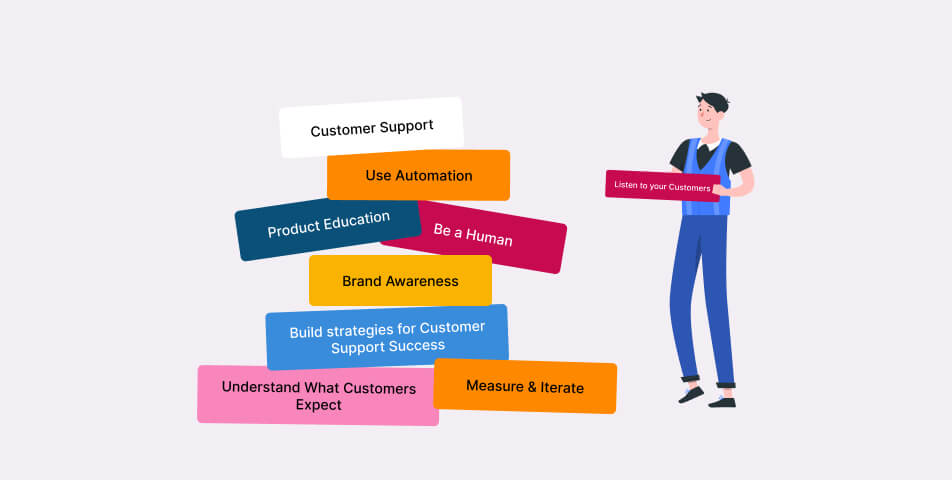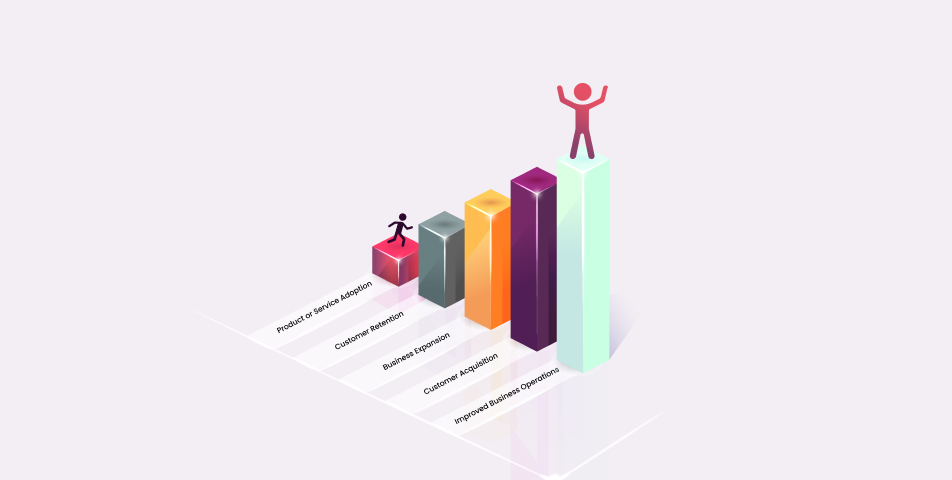Building a Customer Success Strategy is a crucial component of building a great customer experience.
All of you might have heard about the customer Success Strategy. But do you know the significant factors that majorly contribute to it?
A strong customer success strategy provides your customers with the tools that they should use to make the correct usage of the product and:
- Encourages word-of-mouth marketing from satisfied or happy customers
- Decreases churn rates
- Open doors to upselling and renewals
- Drives retention and loyalty in your customer base
Now, let’s dive deep into this guide and learn about the key factors of customer success strategy so that you can incorporate these concepts in your own business.
Key Takeaway :
Building a strong customer success strategy is crucial for any business to increase customer satisfaction, retention, and lifetime value. The top 9 essential elements to build a successful customer success strategy include understanding customer expectations, building strategies for customer support success, brand awareness, product education, using automation, providing reliable customer support, listening to customers, balancing technology with the human touch, and measuring and iterating the strategy over time.
What is a Customer Success Strategy?
A Customer Success Strategy is a proactive approach to ensuring that customers achieve their desired outcomes while using a product or service. It involves understanding customer needs, providing timely support, and offering resources that help them maximize value.
The ultimate goal is to increase customer satisfaction, retention, and lifetime value. Customer Success Journey can be determined if the right strategy is executed perfectly.
Top 9 Customer Success Strategy to Implement in the Business

1. Understand What Customers Expect
Can you ensure that you know your customers fully? Are you actually fulfilling their exact needs?
Before creating any customer success strategy, it’s crucial to learn who you’re trying to serve. The same approach doesn’t need to work for all the customers, and it isn’t easy to ensure that they want you to treat them in the same way.
Here are some methods through which you can move ahead in knowing your customers:
- Provide personalised support to each customer interacting in your business so that trust is built.
- Teaming up with the marketing and sales team helps to allure the efforts with customers.
- Evaluate the customer’s data and make customer segments.
- Contrive customer segments. If you know about the customer’s demographics, your work will get much more accessible.
2. Build strategies for Customer Support Success
After understanding the customer’s expectations, it’s time to start creating internal processes to ensure that it is happening.
Glimpse your segment and brainstorm what they all need to achieve success.
For example: Some customers might work in sales before turning into customers, while if we talk about others, they might go through a low-touch buying procedure. One should also consider other things like:
- Which are the deals in which your sales team is involved?
- What does the handover look like when the team transitions to success or support?
- What does confabulation growth look like? Does it happen at a greater speed for some customers than others?
- What do the pricing tiers have to do with your service level? Are you comfortable providing everyone with the same kind of service?
- Which success or support channels are currently available with which plans?
- Do you provide customer success to everyone?
Building more defined processes sets up both external and internal teams of victory as a part of your customer success strategy.
Read More:7 Customer Success Software Tools to Encourage Growth
3. Brand Awareness
Do you know that 57% of the purchasing decision is made before a customer receives the call?
Today, most B2B first impressions are formed online through email, social media or your company’s website.
Brand awareness is more about attracting the right audience by making them understand what is your purpose in the market.
The brand awareness step is nurturing & qualifying potential customers that you are sure you can help. Thus, you must get a precise definition of what factors make customers a good fit (for your and their benefits).
4. Product Education
Some customers may love your content but do not exactly know why they need that particular service or product. Perhaps your company or product is new to the industry & potential leads are doubtful of your credibility. Or, maybe customers are oblivious to the issues they are facing, push you to figure it out and explain how your company can change their lives.
If you are making your audience understand your product, it is important that you have activated proactive conversation options like Live Chat.
5. Use Automation
Everybody is relieved when they hear the word “automation” as it delivers the highest efficiency by lowering manual efforts.
The smart AI Helpdesk helps in making the finest customer strategy.
Leverage your processes and data from the first initial steps to make communications. Place in the customer lifecycle, behaviours in the product, or even trigger emails off usage patterns.
Automation takes the guesswork out of the sales team and CSMs and helps provide proper communication at the right time to the right people.
6. Customer Support
While you cannot do hand-holding for your customers during their journey, one thing you can do is provide them with reliable customer support. The more the customers use your service or product, the more blockages and questions they’re restricted from answering.
It’s common for any business, but now you can assist your customers by overcoming these problems that will play a significant role in customer success.
Your customer support team should be available to facilitate customers whenever they face any issues. Irrespective of whether the question is easy or tricky, your team should give precise and quick answers that resolve customer requests in the first meeting.
67% of customer issues can be averted if your support team can meet the customer’s demands during the first interaction.
Customer support needs to be aligned in a way to communicate with customers. For faster resolution, it is important that you have equipped the smartest help desk customer support like Desku. It helps to align each customer’s queries under one platform.
Key Features of The Best Customer Support Platform (Desku)
- AI-Helpdesk
- Unified Shared Inbox
- Proactive Live Chat
- No-Code Chatbot builder
- Knowledge Base
- Multiple Integrations
- Customer Management
- and much more…
7. Listen to your Customers
The first thing your customers expect from you is that you listen to them proactively. Exactly know what they are looking for and what they need.
Analyze input points, relate them to their location in the customer support journey, and identify customer segments that don’t accept them. This breakdown helps in understanding customer satisfaction scores and their journey impact. Focus on the critical journey parts affecting customer experience the most.
Always remember to take feedback from your customers. While taking the feedback, keep these things in mind:
- Make the easy way for your customers so they can reach you out.
- Response to anything that a customer sends to you.
- Ask your customers how they use the product.
- If feasible, try to automate feedback aggregation.
For example, if there is a low customer effort score at the beginning of a journey that escalates after two months, you can easily examine new and unique opportunities within the time frame to make things look better. Be aimed with your enhancements rather than scattershot.
Related Article:Hire Best Managers with these Top Customer Service Interview Questions
8. Be a Human
Balance technology with the human touch in your customer success strategy. Prioritize hiring individuals for traits like patience, adaptability, resilience, and empathy in customer support roles.
A strong foundation for strategy and meaningful communication is vital. Metrics matter, but hiring caring individuals is key for customer satisfaction and response time.
Even automation should feel personal, using human language over business jargon.
9. Measure & Iterate
As you create your customer success strategy, you should never forget: How are you and your customers doing?
If you are not keeping these questions in mind regularly and measuring metrics that separate them, you do not know if anything you’re doing will create a huge impact. How will you determine if your customer success strategy is correctly working if you are also not measuring it?
So, you need to consider some metrics to measure customer success strategy. Here are those metrics:
- Churn
- Customer Effort Score (CES)
- Net Promoter Score (NPS)
- Customer satisfaction
- Trial-to-customer conversion rate
- Product Adoption Score
- Retention
- Expansion
You can track them to check whether they are trending over time as you implement new functionalities within your customer success strategy module.
You can also leverage metrics to understand how the processes in your present place affect your customers.
Customer Success Strategy For Your Business
The customer success strategy is as significant as you are living your life and to make your customer happy with your product and services, you should always consider the key factors.
Make changes according to your customer’s needs and wants because customers’ demands are ever-changing and it is important to complement them. One of the important things to consider for customer success is nothing but always staying consistent in customer engagement.
Desku can play the biggest role in drawing the customer success strategy in the e-commerce business. From streamlining the customer queries to multiple platform to resolving them faster like never before.
FAQs
1. What is a Customer Success Strategy, and why is it important?
A customer success strategy is a proactive approach to ensuring customers achieve their goals using a product or service. It focuses on understanding customer needs, providing timely support, and delivering resources to maximize value. This strategy is crucial because it enhances customer satisfaction, reduces churn, and increases retention and lifetime value.
2. How can businesses identify customer expectations effectively?
Businesses can identify customer expectations by:
Providing personalized support to build trust.
Collaborating with sales and marketing teams to align efforts.
Analyzing customer data to create accurate customer segments.
Using customer demographics to tailor services and strategies.
3. Why is customer feedback essential, and how should businesses collect it?
Customer feedback highlights areas for improvement and gauges satisfaction. Businesses should:
Make feedback channels easily accessible.
Respond promptly to customer inputs.
Automate feedback collection when possible.
Analyze trends in customer feedback to identify areas of concern.


